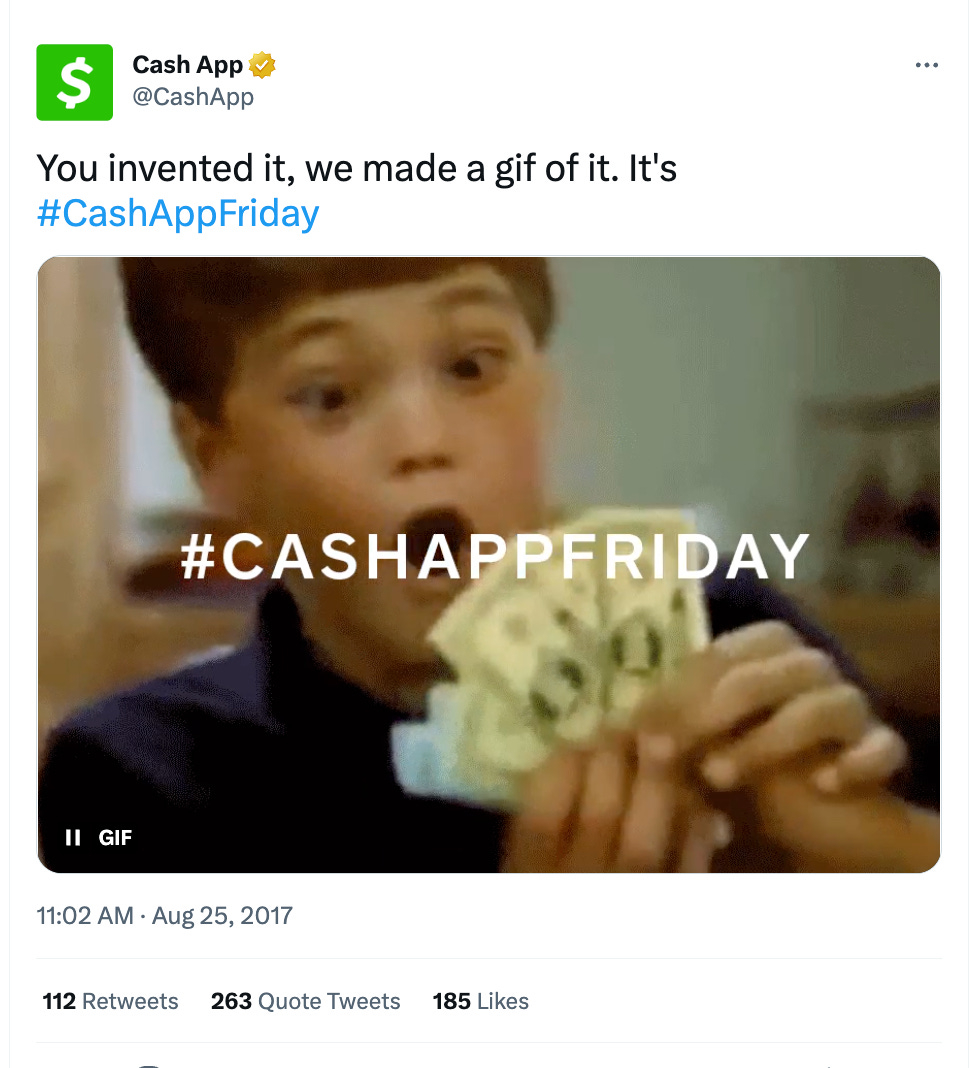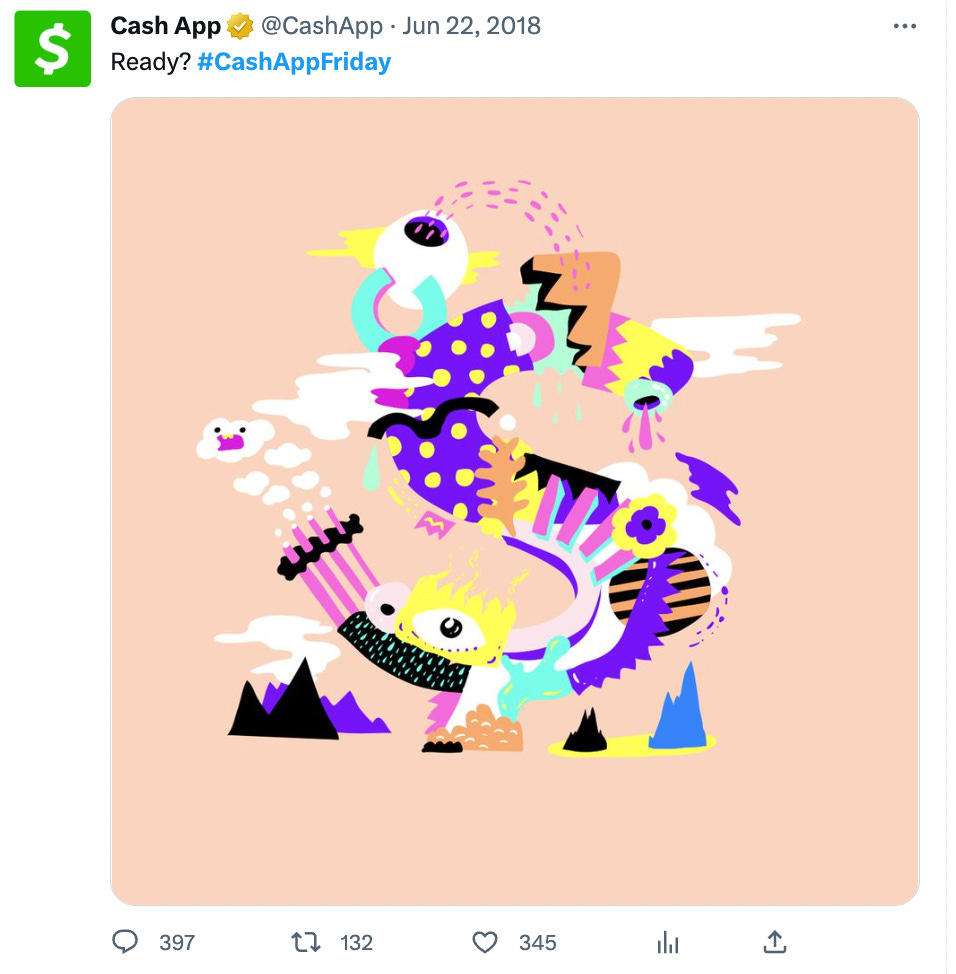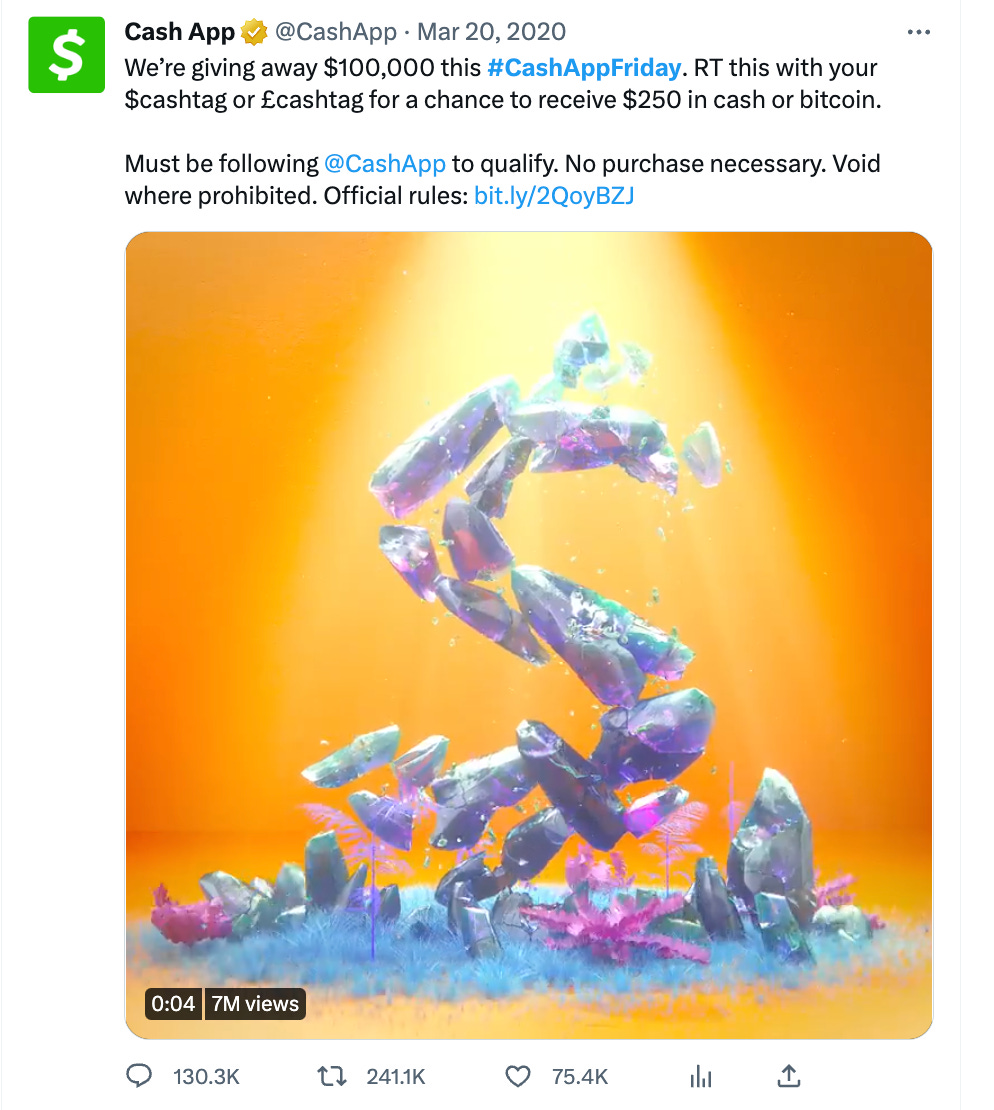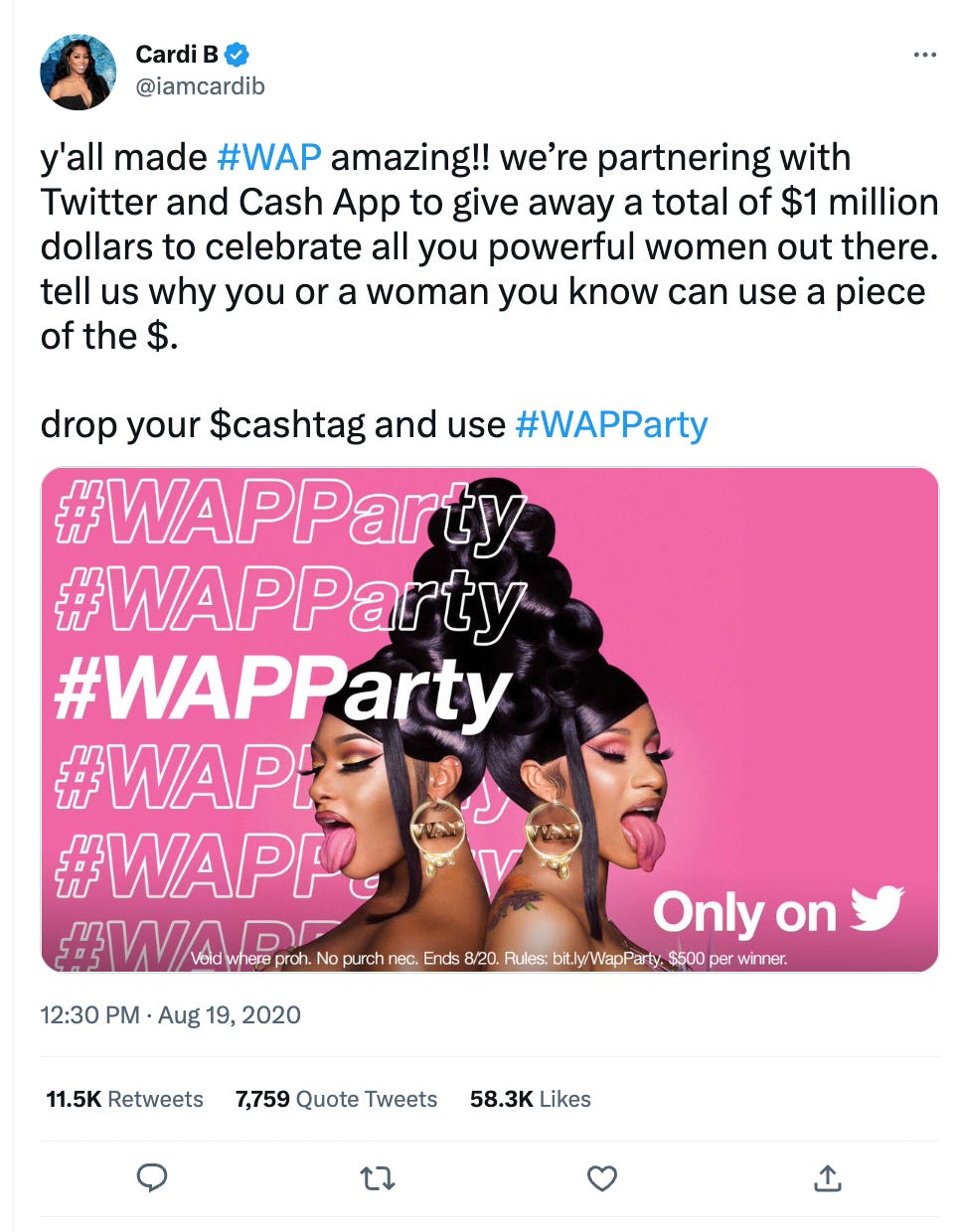🤑 Cash App
How to innovate within a large company
When Cash App first launched in 2013, it tooted its lack of an interface (being an email-first Peer to Peer network), not holding a temporary balance as it differentiated its offering against leading players such as Venmo and Google Wallet.
Fast forward 5 years, in 2017, Cash App surpassed all these competitors by holding temporary balances and investing heavily in its app as the primary mode for users to move money around.
In a world where competitors easily concatenate features, Cash App won the Peer to Peer market by having a culture that helped a small team innovate within a large company to move fast, innovate and adapt.
The Cash app story is a story about how to “build a startup within a large company.”
It’s a story about disrupting the disruptors and legacy players by adopting the proper structure, incentives, and processes.
Cash App is culture!
Cash App, the popular peer-to-peer payment platform, has become a cultural phenomenon and a household name thanks to its widespread adoption and integration into popular music and social media. With over 200 artists, including Tyga, Iggy Azalea, Young Thug, and Lil Durk, mentioning the app in their songs, Cash App has made its mark on the entertainment industry and the world.
The app's success is reflected in its ranking as the top finance app in the App Store and Play Store for the past five years.
This dominant position results from a series of small, strategic decisions made by the Cash App team at Square, which has allowed the late entrant to the P2P money transfer market to challenge and surpass established players like Venmo and fend off competition from tech giant Google.
The Cash App team's ability to outmaneuver its competitors can be attributed to operating principles, which have guided the company's growth and expansion. With these principles in place, the then-small Cash App team was able to navigate a complex and competitive new market and emerge as a leading player in the P2P payment space.
3 Operating Principles
How the Cash App team operated within Square can be summarized in 1 sentence.
Long-term synergy, short-term independence
Tactically speaking, this meant the Cash App team:
Had a distinct culture
Had a separate operating model with centralized decision making
Leveraged expertise from Square but not infrastructure.
—
Culture is particularly important. Culture dictates the heuristics employees use to make quick, informed decisions in a new and challenging environment. When operating in a new arena, as Square was doing in the consumer market, the heuristics they needed to embed in every employee looked different from those at the parent company.
At its core this is why the Cash App team succeeded. They were able to
Selectively take with them the best practices, playbooks, and heuristics that worked from Square
Leave behind others that were not a good fit for the new P2P market
Develop some best practices the hard way; by making & learning from their own mistakes unencumbered by the mothership.
Distribution centric culture
The short-term independence allowed the team to achieve greatness over the long term.
Many of Cash App’s success can be traced to the laser-focused distribution-centric culture Brian Grassadonia, the leader of the Square Cash team, instilled.
The P2P market margins are razor-thin. The only way to make meaningful money is to have millions of people send money around the network and utilize add-on services.
This is vastly different from Seller market Square was in. Each new business that adopted the Square register to manage their offline store paid a fee every time someone bought something from the store. The math was straightforward.
The Cash App team built an obsessive culture over the cost of acquiring each incremental new customer (CAC) in a way that was foreign to their peers working on Square products.
Their own operating model and their business formula revolved around CAC.
When making decisions, building roadmaps, structuring teams or staffing projects it was all about CAC.
They build their own tools and infrastructure in service of lowering CAC.
Water cooler conversations were all CAC this, CAC that, Look at my CAC! —
That distinct obsession with distribution, powered by their independence as a business unit, with 1 central decision maker in Brian Grassadonia, manifested itself in many ways.
Product decisions, gorilla marketing campaigns, and eventually a rebrand and separate brand identity were all done in service of lowering CAC.
—
How Cash App lowered its CAC through Product
Cash App’s innovation came in the form of Instant Bank Deposits; funds were available instantly in your bank account instead of waiting 3 business days to “cash out” using competitors like Venmo or Paypal.
But the real breakthrough was in the UX. Users didn’t have to register or even create an account. The product was CCing “cash@square.com” on any email, there were no accounts, balances or “cashing out.”
Square Cash makes it even easier to manage splitting those big payments, though, with a handy dashboard. The biggest benefit: The service doesn't require the people who are paying you back to sign up for an account.
Joana Stern, WSJ 2014
Square Cash differs from some of the other offerings out there because you don’t have to be an account holder, and the service only requires you to enter your debit card number. In addition, Square Cash is email-client-agnostic, so you can send from any email client.
Brian Grassadonia, Press Release
This seamless experience is a testament to Cash App’s obsessive distribution culture. Its obsession with Customer Acquisition Cost (CAC) resulted in an experience where no one has to sign up, where people can send money and then link their debit, and where receivers did not have to do anything beyond add their debit card number for the money to land.
Powering this experience of sending money that doesn’t require users to create an account (let alone verify your identity 7 ways to Sunday) is a massive investment in cryptographic and security systems. But these are the tradeoffs that only a distribution-obsessed organization would sanction.
—
How Cash App lowered its CAC through Marketing
Cash App's unique distribution centric has proven to be a significant asset, allowing the company to seize pivotal moments and reshape its trajectory from a follower to a leader in the market.
With a deep understanding of cultural trends, Cash App has left competitors like Venmo in its wake and established itself as a true force to be reckoned with
#CashAppFriday
Cash App disrupted the financial landscape by becoming the first app to deliver instant bank deposits on a massive scale. Unlike Venmo and PayPal, which take up to 3 business days for funds to become available, Cash App gave users immediate access to their money.
This feature found a particularly strong following in the lower-income, digitally native, and underbanked communities of the Southeast, particularly in Atlanta, where many live paycheck to paycheck. Cash App's rise to prominence as the primary bank for many in these markets was a gradual process.
As Cash App started gaining traction in this market, a fascinating trend emerged on Twitter, where users began to ask for financial assistance by sharing their $Cashtags on Fridays, payday. This led to a sense of community, as fellow users organically started sending money to one another in acts of generosity and support.
So Cash App leaned in. First, with the memes.
Then with the money
Then with the big money
Then with the influencers
The result
The end result of the distribution obsessed culture Cash App build was a customer acquisition cost (CAC) of $5-$10 for every new active user.
To put it into context, Cash App can acquire customers at 10%-30% the cost of a neobank, and 1%-3% the cost of a traditional bank.
Product Velocity
A second order effect of the three principles (distinct culture, centralized decision making, and separate infrastructure) that governed the Cash App within the larger Square ecosystem is the speed at which they shipped new features.
Cash App capitalized on its success in the Southeast in 2016/2017 by doubling down on its efforts to serve the underbanked population. In a two-year span, the company launched various innovative services, including a debit card, rewards program, ATM withdrawals, and payroll deposits. This aggressive expansion set the stage for Cash App's explosive growth.
A visual representation of Cash App's product releases, compared to those of Venmo, highlights the extent of the company's aggressive shipping velocity
The result
These product releases compounded over time, accelerating Cash App’s market penetration and strengthening its network effects
Every release generated more profit from each active user which the company poured back into customer acquisition.
By late 2021, Cash App generated upwards of $45 per active user per year resulting in a payback period of under 1 year and an average gross profit return of X6 over the lifetime of a customer.
Takeaways
Few companies can build an ecosystem of products to upsell their core customers, but a handful can build two distinct products that dominate their respective markets.
Square is one of those.
It was able to do so by following three operating principles:
Build a team that has a distinct culture
Culture should obsess over the unique challenges of the industry. In Cash App’s case that was Customer Acquisition Cost
End result: #CashAppFriday, $10 Acquisition Machine
Leveraged expertise from Square but not infrastructure.
Give the team know-how but unencumber them from technical debt, processes and structures already in place. The team’s needs are unique, and so are their solutions. Don’t box them, let them run wild!
End result: An ecosystem of underbanked products that work seamlessly together driving gross profit from $5 to $47
Had a separate operating model with centralized decision making
Allow the team to move fast, pivot when necessary and learn the ropes of the new industry at their own pace. Trust that they will make the right decisions with the right leadership in place
End result: A 5 year tremulous journey to the #1 finance app on App Store and Play Store
That’s it for today. Talk soon 😉
Ali Abouelatta












